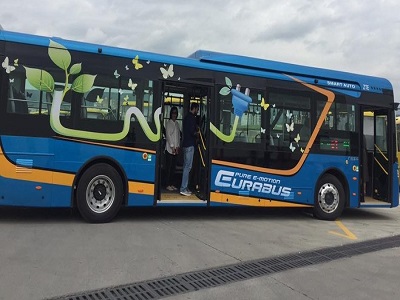On May 3, the US-based World Resource Initiative (WRI) published ‘How to Enable Electric Bus Adoption In Cities Worldwide’, which examines the process of adopting e-buses in sixteen case study cities. Tbilisi City Hall took the first couple of steps necessary to introduce the first electric bus in 2018 and is expected to scale up the number to 200 from 2020. Thus, this study could serve as guidance of what to look out for when changing existing bus fleets to e-buses. To smoothly adopt electric buses and make the process successful and sustainable, the report identifies four stages:
• Stage 0 to 1 centers around the reason why stakeholders wish to adopt e-buses in the first place. City officials and bus operators need to focus on whether e-bus adoption can match the city’s environmental targets. Before moving on to the next stage, stakeholders also need to ensure that there is infrastructure capacity that can handle the adjustment. This includes investigating whether the existing bus fleet hinders the introduction of e-busses, road conditions, electricity generation, and transmission and distribution ability.
• Stage 1 to 2 can be summarized as a trial and error phase, where earlier analyses and theories will be put together in a flexible action plan with achievable targets. The outcome of this phase in not only to design and launch a pilot project but also learn from the knowledge acquired during the process that could be of use for long-term planning.
• Stage 2 to 3 should call for a determination of what targets to achieve based on acquired knowledge from piloted studies. This stage should also result in a long-term plan on how to manage the large-scale adoption of e-buses that fit into the local needs of the city. Not only should the financial sources be secured in a long-term perspective, but there is also a need to determine which bus routes are better suited to introduce e-buses. Local manufacturers, stakeholder coordination and public awareness are three major aspects which successful cities seem to have, and these could speed the process of adopting e-buses.
• The second last stage focuses not only on launching the full-scale project with its bus route network but it should also contain a holistic, detailed analysis of the project. This analysis should plan for needed actions that could pave the way for future expansions, taking in consideration aspects such as innovative financing, sustainable sources of electricity or durable infrastructure.
• The last stage focuses on evaluating and monitoring the ongoing process of the implementation of e-buses. This could include bus operators evaluating the bus network and research making a comprehensive assessment on the adoption process and all its aspects.
Alongside this report, the WRI also recently launched Barriers to adopting electric buses, whichvexemplifies three types of barriers faced by sixteen cities in the Global South. The three key barriers discussed in the WRI report are the following:
• Technological (identifying the technological barriers and enablers of e-bus technology by decision-makers);
• Financial (difficulties in changing procurement procedures and finding sustainable financing);
• Institutional (lack of practical public policies and leadership as well as lack of institutional capacity and access of land).











